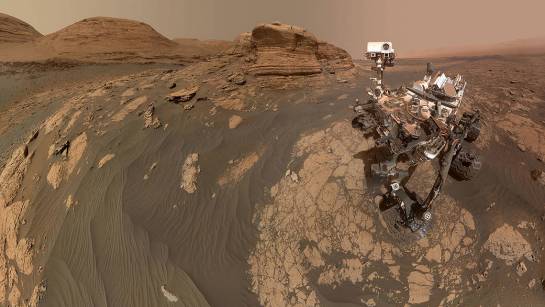Ten years ago, the wanderer curiosity NASA, the SUV-sized explorer descended to the red planet to collect data and prove that, billions of years ago, Mars met the conditions necessary to harbor microscopic life.
Since then, the vehicle has traveled nearly 29 kilometers and climbed 625 meters while exploring the gale crater and the foothills of Mount Sharp within it. He analyzed 41 samples of rocks and surface materials using a suite of science instruments to learn what they reveal about Earth’s rocky sibling.
It also motivated a team of engineers to find ways to minimize wear and keep it running. In fact, Curiosity’s mission was recently extended for another three years, allowing it to continue among NASA’s fleet of large astrobiological missions.
The rover studied the Martian skies, capturing images of glowing clouds and little moons to drift. Its radiation sensor allows scientists to measure how much high-energy radiation future astronauts will be exposed to on the Martian surface, helping to figure out how to keep them safe.
In Search of Mars’ Living Past
According to NASA, the most important thing is that the wanderer determined that liquid water, as well as the chemical components and nutrients needed to sustain life, have been present for at least tens of millions of years in Gale Crater. This one had a lake in the past, the size of which increased and decreased over time. Each top layer of Mount Sharp serves as a record of a more recent era of the Martian environment.
Poster for the 10th anniversary of the agency’s Curiosity Mars rover on the Red Planet. / NASA/JPL-Caltech.
now he wanderer is moving through a gorge that marks the transition to a new region, which is believed to have formed when the water was drying up, leaving behind salty minerals called sulfates.
“We are seeing evidence of dramatic changes in the ancient Martian climate,” he commented. Ashwin Vasavada, a scientist at NASA’s Jet Propulsion Laboratory (JPL), “The question now is whether the habitable conditions Curiosity has encountered so far have persisted through these changes. Did they disappear never to return, or did they come and go over millions of years?
Curiosity has made incredible progress on the mountain. In 2015, for example, the team captured an image of “Postcard” from distant hills. A mere dot within this photograph is a stone the size of Curiosity dubbed Novo Destino Island, and nearly seven years later, the vehicle passed it in July on its way to the sulfate region.
The team plans to spend the next few years exploring this area, which includes targets such as the Gediz Vallis canal, which may have formed during a flood late in Mount Sharp’s history, and large cemented fractures that partially show the effects of groundwater. from the mountain.
Different maintenance strategies
The team in charge of ensuring the survival of the wanderer catalogs every crack in the wheels, tests every line of computer code before it’s sent into space, and drills through infinite rock samples at JPL’s Mars Yard, ensuring Curiosity can do the same safely on the Red Planet.
“Once you land on Mars, everything you do is based on the fact that there’s nobody around to fix it for 100 million miles,” he says. Andy Mishkin, interim project manager for Curiosity at JPL. “It’s about making intelligent use of what’s in the rover.”
The circle indicates the location of a Curiosity-sized rock that the rover has recently passed. On the left is the “Paso Paraitepuy”, the place where Curiosity is now traveling. / NASA/JPL-Caltech
O drilling process Curiosity, for example, has reinvented itself several times since landing. At one point, the drill was out of service for over a year as engineers redesigned its use to more closely resemble a hand drill.
More recently, a set of braking mechanisms that allow the robotic arm to move or stay in place has stopped working. While the arm is functioning normally with a spare set, the team has also learned to drill more carefully to preserve the new brakes.
Also, to minimize the wheel damageengineers keep an eye out for tricky spots like the rough terrain they recently discovered, and they’ve also developed a traction control algorithm to help.
While the Energy, Curiosity has a long-lasting nuclear power battery instead of solar panels. As the battery’s plutonium atoms decay, they generate heat that the rover converts into energy. Due to the gradual breakdown of atoms, the vehicle cannot do the same amount of activity in one day as it did during its first year.
Mishkin said the team continues to calculate how much energy the rover uses per day and has discovered what activities can be done in parallel to optimize the rover’s available energy. Through planning and engineering tricks, the team believes the rover is still years of travel in front of.
